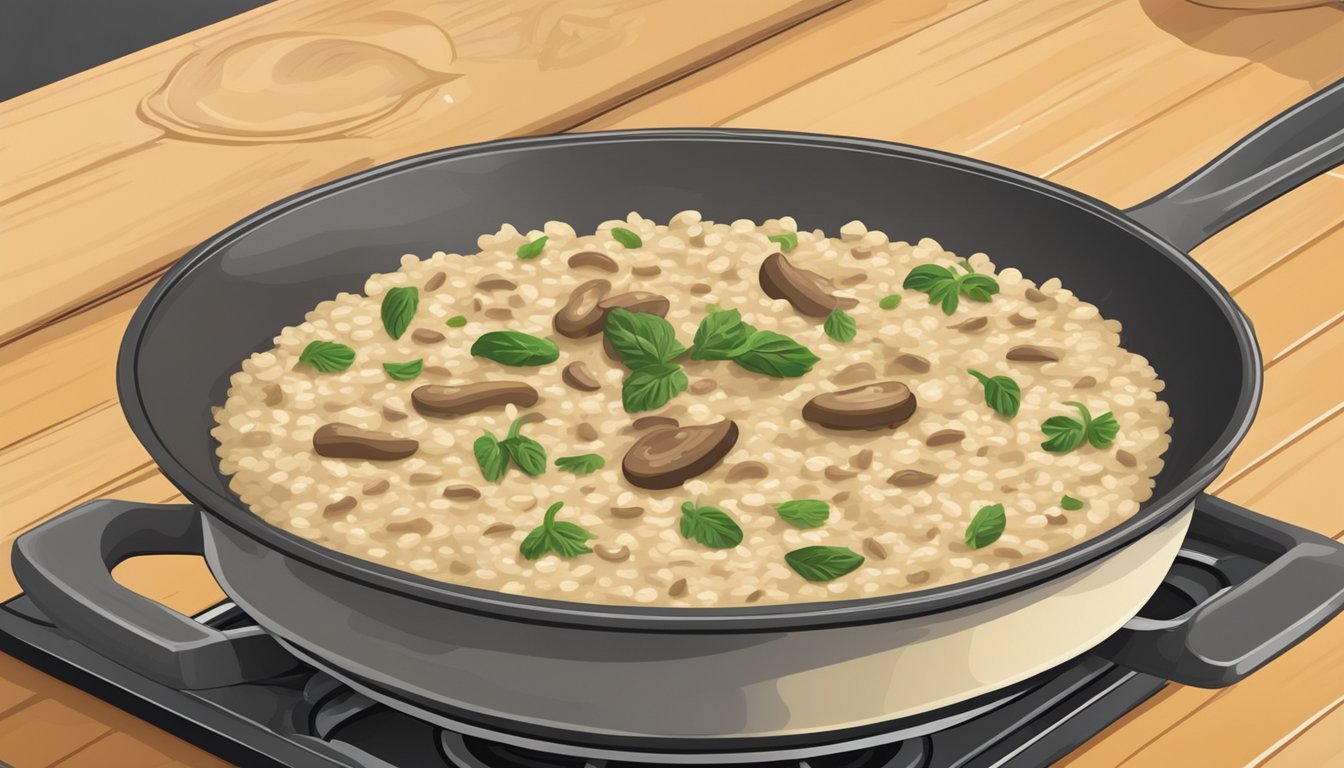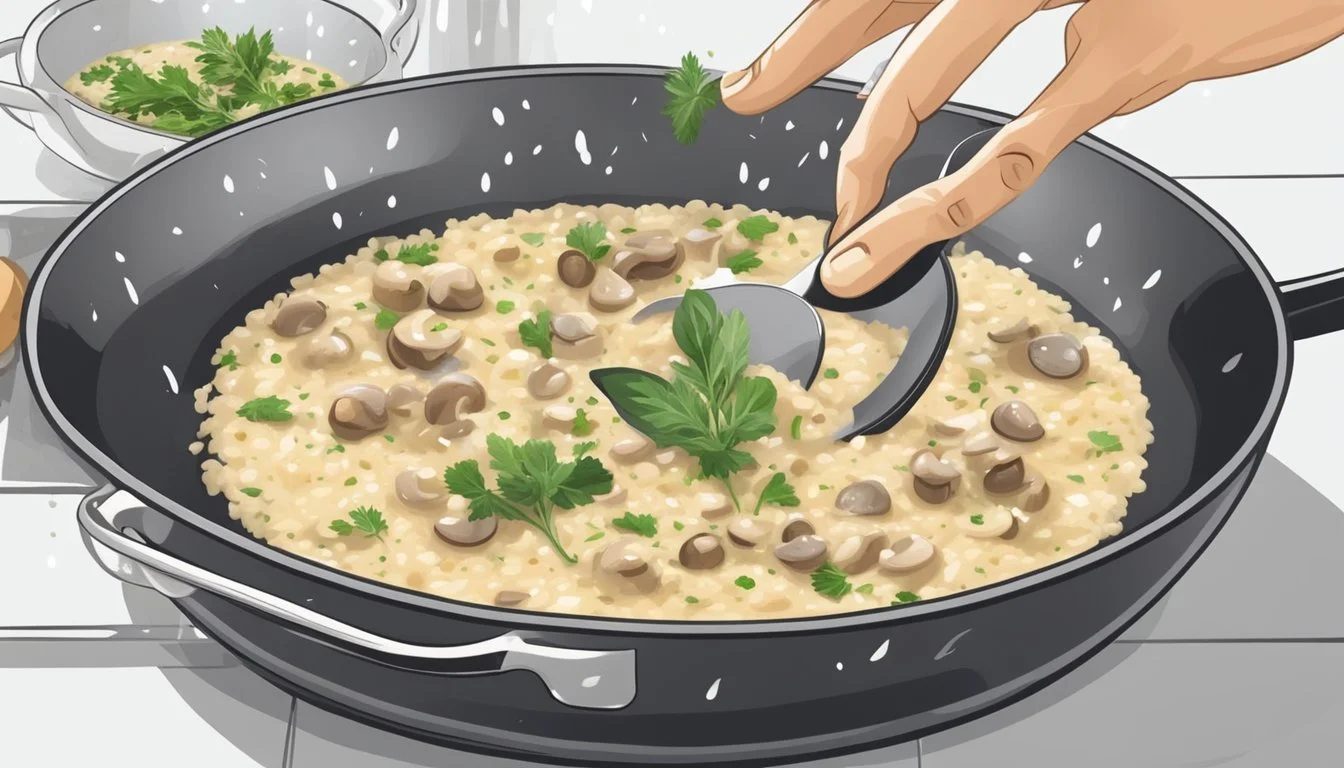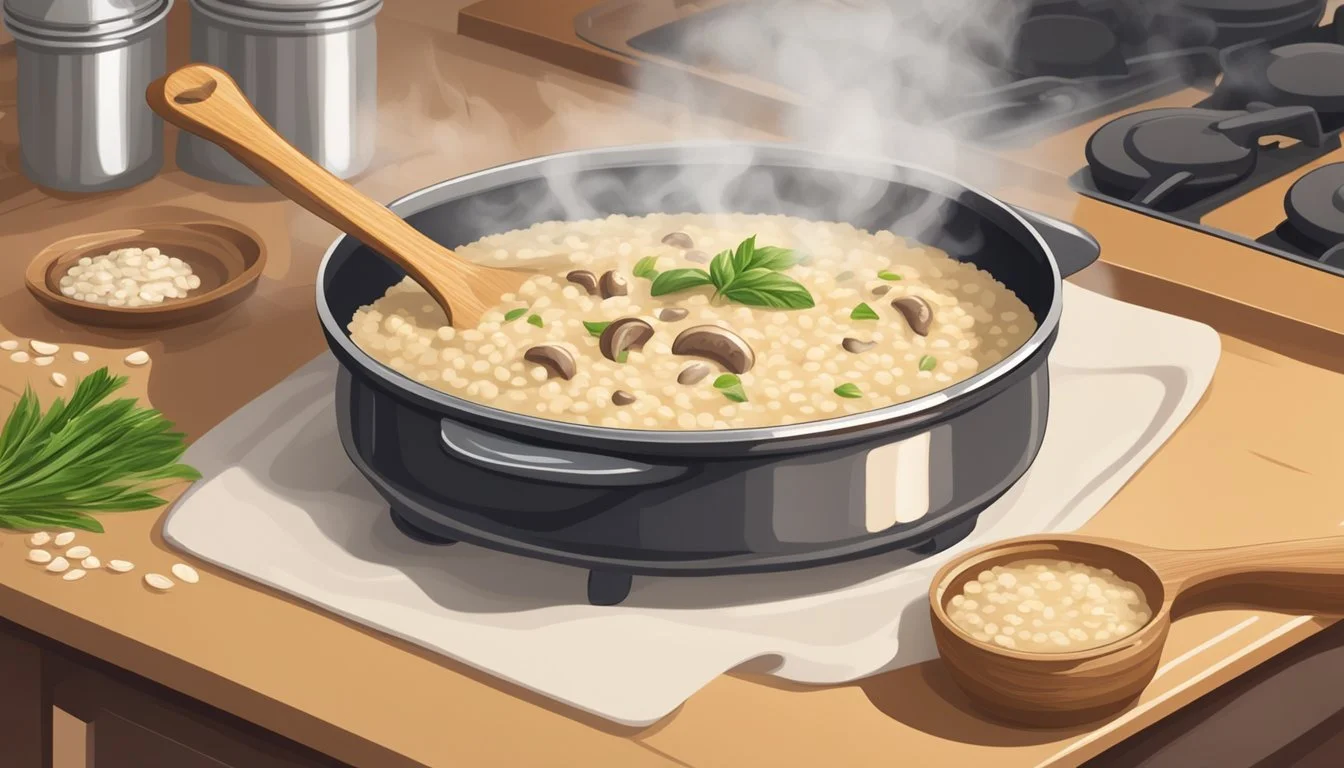Best Way to Reheat Barley Risotto with Mushrooms
Ensuring Creaminess Retention
When it comes to reheating barley risotto with mushrooms, ensuring the creamy consistency and delicate flavors are retained is paramount. Barley risotto, known for its chewy texture and nutty flavor, can become dry and unappetizing if not reheated properly. The best way to reheat risotto focuses on gently restoring its warmth while maintaining its distinct creaminess. This process is crucial to prevent the grains from becoming too soft or the dish losing its rich, earthy mushroom undertones.
Several methods can be used to reheat barley risotto effectively, but some approaches lead to better results than others. Cooking experts often recommend gentle heat and the addition of some liquid to bring back the risotto's original luscious state. Some liquid, whether it's stock, water, or a pat of butter, can revive the dish without compromising the integrity of its ingredients. This helps in keeping the barley plump and the mushrooms (What wine goes well with mushrooms?) tender, ensuring that each spoonful is as satisfying as when it was first made.
While the microwave may offer a quick fix, it may not always deliver the best texture or flavor. More controlled techniques like stovetop reheating with additional moisture or oven-based methods tend to yield a dish that’s evenly heated and just as flavorful as the initial serving. The goal is to apply heat in a manner that allows the risotto to absorb
Understanding Risotto
Risotto is an Italian rice dish known for its creamy consistency and rich flavor profile. The dish's allure lies in the careful blending of starchy rice with flavorful liquids.
Key Components of Risotto
Rice: The foundation of any risotto is the rice. Arborio rice, a medium-grained variety, is traditionally used due to its high starch content which contributes to the dish's creamy texture.
Starch Content: The creaminess of risotto comes from the gradual release of starch as the rice cooks and absorbs liquid.
Importance of Creaminess in Risotto
The hallmark of a good risotto is its creaminess; this is not derived from cream itself but from the natural starches within the rice. A creamy texture is essential, as it indicates a risotto that has been cooked properly, with constant stirring to encourage starch release. This creamy consistency makes the dish rich and satisfying.
Storing Risotto for Reheating
Proper storage is paramount to maintain the quality of barley risotto with mushrooms for reheating. By ensuring the right environment and safety measures, the risotto’s creaminess can be preserved.
Ideal Storage Conditions
For optimal freshness, barley risotto should be stored in the refrigerator within two hours of cooking to prevent the growth of bacteria. Refrigeration should occur promptly, and the risotto should be kept at a consistent temperature of 40°F (4°C) or below. The use of an airtight container is essential to prevent the absorption of odors and dehydration. If one anticipates a longer delay before reheating, storing in the freezer is an option, which will require the risotto to be tightly wrapped in plastic wrap and then in aluminum foil to avoid freezer burn and preserve flavor.
Refrigerator:
Ensure the risotto cools to room temperature before storing.
Place in an airtight container.
Consume within 48 hours for best results.
Freezer:
Allow risotto to cool completely.
Wrap with plastic wrap, follow with aluminum foil.
Use within 1 month for optimal quality.
Preventing Food Poisoning
Safety is crucial when handling leftovers like risotto. It should never be left out at room temperature for more than two hours. One should reheat only the needed portion, minimizing temperature variations for the remaining risotto. If the risotto has been stored in the freezer, it must be thawed in the refrigerator prior to reheating to ensure even and safe warming. Additionally, one must always check for signs of spoilage, such as off-odors or a change in texture, before consumption. To transform leftover risotto into another meal, one can make risotto balls or arancini, which should also be stored in an airtight container in the fridge or freezer following the same guidelines.
Pre-Reheating Preparation
Prior to reheating barley risotto with mushrooms, one must not overlook two critical steps: allowing the risotto to reach room temperature and introducing additional liquid to maintain its signature creaminess. Properly executing these steps ensures the risotto retains its quality and flavor.
Bringing Risotto to Room Temperature
It is imperative that one removes their barley mushroom risotto from the refrigerator and lets it sit at room temperature for approximately 20 to 30 minutes. This gradual approach to temperature change helps in evenly reheating the risotto later, thus preventing it from becoming overcooked around the edges while remaining cold in the center.
Key Point:
Thawing time: 20-30 minutes
Adding Liquid to Risotto
When reintroducing moisture to the risotto, one has a variety of options. It's essential to add enough liquid to ensure the risotto regains its creaminess without becoming too runny. For each cup of risotto, generally add about:
2-3 tablespoons of stock (chicken, vegetable, or mushroom)
Alternatively, one can use water, albeit stock is preferred for added flavor
A drizzle of olive oil or a small knob of butter can also enhance richness
One should gently stir the liquid into the risotto to evenly distribute it.
Liquid Addition Table:
Liquid Type Amount per 1 cup of Risotto Purpose Stock 2-3 tablespoons Adds flavor, promotes creaminess Water 2-3 tablespoons Alternative to stock, maintains moisture Olive Oil/Butter 1 tablespoon Boosts richness, aids texture
By attending carefully to these preparatory steps, one ensures that the barley mushroom risotto will emerge from the reheating process as creamy and delightful as when it was first served.
Reheating Techniques
When reheating barley risotto with mushrooms, one must balance restoring the dish's temperature without compromising its creaminess. Each technique below emphasizes gently warming the risotto while maintaining its inherent moisture.
Stovetop Reheating
To reheat risotto on the stovetop, place it in a non-stick pan over low heat. One should add a small amount of broth or water to reintroduce moisture and assist in evenly warming the dish. Continuous stirring is crucial to prevent sticking and to ensure the risotto regains its creamy consistency.
Microwave Reheating
Using a microwave, risotto can be reheated quickly by placing it in a microwave-safe bowl. It is recommended to sprinkle the risotto with a bit of water or broth before reheating. The dish should be covered with a microwave-safe lid or paper towel and heated in 30 to 60-second intervals, stirring occasionally to distribute heat uniformly.
Oven Reheating
For oven reheating, preheat the oven to around 350°F (175°C). The risotto should be transferred into a baking dish and lightly moistened with broth or water. Cover the baking dish with foil to lock in moisture and heat the risotto for approximately 10 to 15 minutes, ensuring it doesn't overcook or dry out.
Using a Steamer Basket
One can also reheat risotto using a steamer basket over a pot of simmering water. The risotto should be placed in a heatproof bowl and set inside the basket. Cover the pot and allow the risotto to steam, stirring occasionally until thoroughly heated. This method helps retain the risotto's original texture and moisture content.
Additional Risotto Reheating Tips
To maintain the creaminess and prevent dryness in barley mushroom risotto, one must pay attention to moisture retention and temperature control during reheating.
Avoiding Dryness and Loss of Texture
Proper reheating preserves the dish’s creamy texture. It is essential to add liquid to the risotto to replace moisture lost since its initial cooking. A small amount of broth or water can be stirred in gently. The key is to stir occasionally to redistribute the heat and incorporate the added liquid evenly. The stirring should be gentle to avoid breaking the grains but frequent enough to maintain an even texture.
Checking for Optimal Temperature
Using a food thermometer is the most accurate way to ensure the risotto reaches a sufficient internal temperature of 165°F (74°C) without overheating. This helps prevent microbial growth, ensuring that the risotto is both safe to eat and creamy. One should test different spots in the risotto to account for uneven heating, especially when using a microwave.
Innovative Ways to Repurpose Leftover Risotto
Turning leftover barley risotto into delectable dishes can be both a practical and creative culinary endeavor. This section explores two distinct methods to transform leftover risotto with mushrooms into appetizing treats that are perfect for various eating occasions.
Creating Risotto Balls and Arancini
One can convert leftover barley mushroom risotto into risotto balls, also known as arancini. These fried delights are traditionally stuffed with cheese or peas and coated with breadcrumbs for a crispy exterior. Here's how to make them:
Shape the risotto into balls, incorporating a piece of mozzarella in the center if desired.
Dip each ball in beaten eggs, then roll in bread crumbs to coat.
Pan-fry the balls in hot oil until golden and heated through, or bake at 375°F (190°C) until crispy.
Making Risotto Fritters
Alternatively, one can prepare risotto fritters—a mixture of risotto and additional binding ingredients, pan-fried to achieve a creamy center with a crunchy surface.
Mix the cold risotto with an egg to help binding.
Form into small patties and dredge in breadcrumbs.
Pan-fry in oil over medium heat until each side is a crispy golden brown.
Both risotto balls and fritters make excellent appetizers or snacks, showcasing the versatility of barley mushroom risotto in leftover transformations.
Pairing and Serving Suggestions
When serving barley risotto with mushrooms, the choice of accompaniments can elevate the dish, and a thoughtful presentation ensures the risotto's creaminess is enjoyed at its best.
Selecting the Right Accompaniments
For a harmonious meal, selecting the right side dishes is essential. One should consider a green salad dressed with a vinaigrette to balance the richness of the risotto. The sharp and refreshing flavors of the salad will complement the creamy texture of the barley risotto. Additionally, offering grated cheese, such as Parmesan, allows guests to add a nutty and salty flavor enhancing the overall taste experience.
Serving Temperature and Presentation
Barley risotto should be served warm to maintain its creaminess. It's optimal to serve it between 155°F to 165°F (68°C to 74°C), ensuring that the dish is heated thoroughly without drying out. In terms of presentation, one might spoon the risotto into a pre-warmed bowl or plate, garnishing with a sprig of thyme. This not only adds a flavorful touch but also a hint of color to the Italian dish. Presentation is key to appealing to the senses and making the dish enticing to eat.
Conclusion
Reheating barley risotto with mushrooms can be deftly managed to maintain its signature creaminess. One should opt for gentle heat and a touch of additional liquid to revive its lush texture. Whether it's vegetable broth or a low-sodium chicken broth, adding a splash ensures the risotto doesn’t dry out. A dollop of butter can also enhance its richness, ensuring the silky mouthfeel of the dish is retained.
For those who appreciate the depth of flavor, introducing a dry white wine can elevate the risotto during reheating while complementing the earthy tones of sautéed mushrooms. Onion and garlic, pivotal in risotto recipes, should have their aromatic presence maintained, not overshadowed. Careful stirring is crucial; it distributes heat evenly and keeps the grains intact.
Microwave Reheating:
Add liquid (broth or wine): 1 tbsp per cup of risotto
Stir in butter for richness
Cover with a microwave-safe lid
Heat on medium, stirring every 30 seconds
Stovetop Reheating:
Pour risotto into a pan
Stir in broth or wine and butter
Reheat over low heat, stirring frequently
Oven Reheating:
Spread risotto in an oven-safe dish
Mix in additional liquid and dots of butter
Cover with foil to trap moisture
Warm at 300°F until heated through
The creaminess of a barley risotto with mushrooms hinges on a balance of temperature and added moisture. By following these strategies, one ensures a result that is satisfyingly close to the original preparation, delivering a rich and flavorful dish to the table once more.








